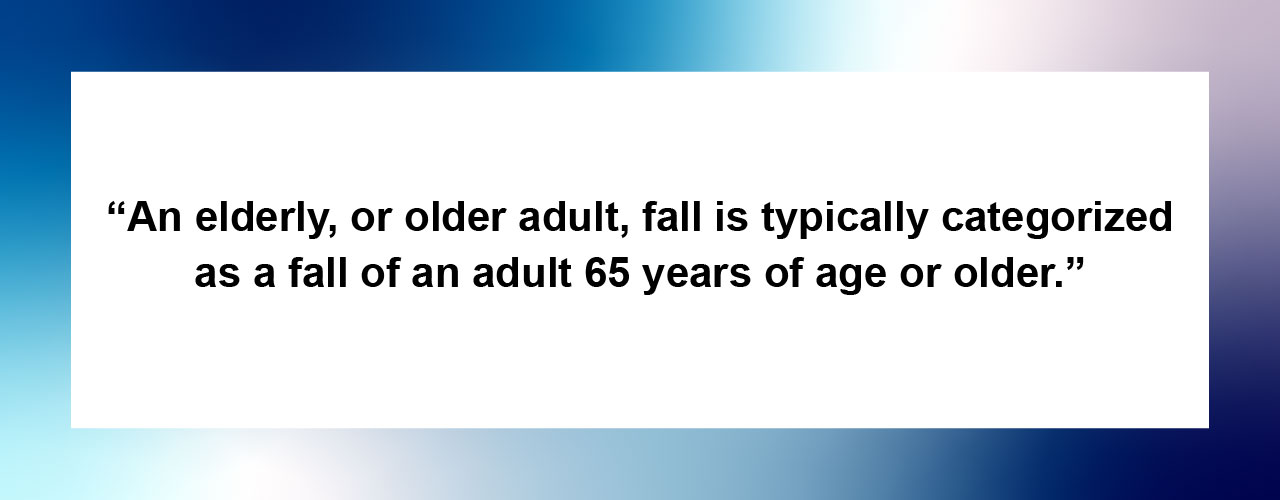Elderly Falls: Facts and Statistics
Elderly Falls: Facts and Stats
Losing one’s balance and falling, or simply misstepping, is a common hazard for the elderly. The fact is that most adults 65 years of age or older will experience a serious fall in their lifetime. Get the facts about falls in the elderly and how you can protect your loved ones.
Fact: over 36 million Americans over the age of 65 fall each year.
According to the National Safety Council, falls injure about 2.4 million people in the United States each year and kill about 27,000. In 2009, an estimated 2.5 million people over age 65 fell resulting in more than 1.1 million injuries, according to a study published in the American Journal of Preventive Medicine (November 2010). Falls caused 1 in 5 deaths among adults older than 75 and fully one-third of all nonfatal injuries are treated in emergency departments. Falls were also the leading cause of nonfatal injury among people 65 and older in 2009. The sobering facts make it clear that we cannot afford not to be proactive and do something about falls prevention for our elderly loved ones.
Although falls among the elderly are not uncommon, they can often be serious and costly. They’re also one of the leading causes of death among seniors. Below you’ll find some essential fall facts that you need to know.
What is considered an Elderly or Older Adult Fall?
An elderly, or older adult, fall is typically categorized as a fall of an adult 65 years of age or older.
What are the 3 Types of Falls?
Based upon a classification system developed by Janice Morse, falls can be categorized into three types:
Physiological (anticipated) – these are falls that can be identified in advance due to risk factors like mental status, abnormal gait, frequent toileting needs, or high-risk medications.
Physiological (unanticipated) – these are falls that occur in patients with low fall risk and occur from events like seizures, strokes, or syncope.
Accidental – these falls occur in low-risk patients from physical, environmental hazards.
Preventing Elderly Falls
Falls can be prevented. These are some simple things you can do to keep yourself from falling.
Prevent Falls by Talking to Your Doctor
- Evaluate your risk. Ask your doctor or healthcare provider about specific things you can do to prevent falls.
- Review your medicines. Ask your doctor or pharmacist if any of your medications could make you dizzy or sleepy. This should include prescription medicines and over-the-counter medicines.
- Vitamin D. Ask your doctor or healthcare provider about any supplements you are taking.
Prevent by Strength and Conditioning
- Exercise. Take up an exercise program with movements that make your legs stronger and improve your balance.
Visit Your Ophthalmologist
- Yearly Eye Exams. Complete yearly check-ups with your eye doctor and order new eyeglasses if needed.
- Order New Glasses. Sometimes bifocal or progressive lenses can make things seem closer or farther away than they really are. You may want to order a pair of glasses with only your distance prescription for outdoor activities.
Improve Your Home’s Safety
- Eliminate Hazards. Remove items that are tripping hazards.
- Add Grab Bars. Add bars inside and outside your tub or shower and next to the toilet.
- Install Railings. Add railings to both sides of stairways.
- Improve Lighting. Ensure your home has lots of light. Install more or brighter light bulbs.
- Place Items Within Reach. Keep regularly used items in cabinets at arm’s length.
- Increase Bathroom Safety. Place non-slip mats in the bathtub and on shower floors.
Elderly Falls: Serious and Costly
- 37.3 million falls are severe enough to require medical attention occur each year.
- 300,000 older people are hospitalized for hip fractures each year.
- More than 95% of hip fractures are caused by falling.
- Falls are the second leading cause of traumatic brain injuries.
- In 2015, the total medical costs for falls totaled more than $50 billion. Medicare and Medicaid covered 75% of these costs.
What Conditions Make You More Likely to Fall?
Most falls are caused by a combination of risk factors. The more risk factors a person has, the greater their chances of falling. Research has identified many conditions that contribute to falling. These are called risk factors. Many risk factors can be changed or modified to help prevent falls. They include:
- Lower body weakness
- Vitamin D deficiency (that is, not enough vitamin D in your system)
- Difficulties with walking and balance
- Use of medicines, such as tranquilizers, sedatives, or antidepressants. Even some over-the-counter medicines can affect balance and how steady you are on your feet.
- Vision problems
- Foot pain or poor footwear
- Home hazards or dangers
What Can Happen After a Fall?
Many falls do not cause injuries. But one out of five falls does cause a serious injury such as a broken bone or a head injury. These injuries can make it hard for a person to get around, do everyday activities, or live on their own.
- Falls can cause broken bones, like wrist, arm, ankle, and hip fractures.
- Falls can cause head injuries. These can be very serious, especially if the person is taking certain medicines (like blood thinners). An older person who falls and hits their head should see their doctor right away to make sure they don’t have a brain injury.
- Many people who fall, even if they’re not injured, become afraid of falling. This fear may cause a person to cut down on their everyday activities. When a person is less active, they become weaker, and this increases their chances of falling.
Protect Your Elderly Loved Ones from Falling – Take Action
Speak Up: Talk openly with your loved one and their healthcare provider about fall risks and prevention.
- Tell a healthcare provider if your loved one has fallen. Also speak to an HCP if they are worried about falling or seem unsteady.
- Keep an updated list of your loved one’s medications. Show a healthcare provider or pharmacist all their medications, including over-the-counter medications, and supplements. Discuss any side effects, like feeling dizzy or sleepy.
- •Ask their healthcare provider about taking vitamin D supplements to improve bone, muscle, and nerve health.
Keep Moving: Activities that improve balance and strengthen legs (like Tai Chi) can prevent falls.
- Exercise and movement can also help your loved one feel better and more confident.
- Check with their healthcare provider about the best type of exercise program for them.
Have Eyes and Feet Checked: Being able to see and walk comfortably can prevent falls.
- Have their eyes checked by an eye doctor at least once a year.
- Replace eyeglasses as needed.
- Have their healthcare provider check their feet once a year.
- Discuss proper footwear and ask whether seeing a foot specialist is advised.
Make the Home Safe: Most falls happen at home.
- Clean-up: Create a clutter-free home.
- Remove small throw rugs or use double-sided tape to keep the rugs from slipping.
- Add grab bars in the bathroom—next to and inside the tub, and next to the toilet.
- Have handrails and lights installed on all staircases.
- Make sure the home has lots of light.

